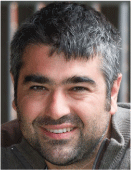Importance of Australia’s offshore oil and gas infrastructure for fish
D. McLean A B H , T. Bond B C , E. S. Harvey D , D. Ierodiaconou E , K. Cure A , M. Taylor B C , S. Whitmarsh E , T. Sih F G and P. I. Macreadie E FA Australian Institute of Marine Science, Indian Ocean Marine Research Centre, Perth, WA 6009, Australia.
B The UWA Oceans Institute, The University of Western Australia, 35 Stirling Hwy, Perth, WA 6009, Australia.
C School of Biological Sciences, The University of Western Australia, 35 Stirling Hwy, Perth, WA 6009, Australia.
D School of Molecular and Life Sciences, Curtin University, GPO Box U1987, Perth, WA 6845, Australia.
E Centre for Integrative Ecology, School of Life and Environmental Sciences, Deakin University Burwood Campus, Vic. 3125, Australia.
F Blue Carbon Lab, Centre for Integrative Ecology, Deakin University Burwood Campus, Vic. 3125, Australia.
G School of Biological Sciences, Monash University, Clayton Vic. 3800, Australia.
H Corresponding author. Email: d.mclean@aims.gov.au
The APPEA Journal 61(2) 429-437 https://doi.org/10.1071/AJ20106
Accepted: 23 March 2021 Published: 2 July 2021
Abstract
An assessment to remove, partially remove, leave in situ or repurpose oil and gas infrastructure at end of field life can be more robust if it uses rigorous, relevant and accurate data. We used industry remotely operated vehicle (ROV) video, specialised high-definition stereo-video systems and partnered with industry to enhance future ROV campaigns for the collection of scientific data from infrastructure. Data from 17 pipelines and 51 wells were analysed to report on patterns in fish species richness and abundance in Australia’s north, north-west and south-east regions. This represents the largest synthesised data set on marine communities for pipelines and wells, globally. We observed 401 fish species, 350 along pipelines and 113 on well infrastructure. Potential new fish species, critically endangered species, unique behaviours and diverse communities were discovered around pipeline and well infrastructure. Predicting the environmental consequences of different decommissioning options relies on a region-specific understanding of the ecological communities that are associated with these structures. We showcase marine research from around Australia that will inform local decommissioning and contribute to a more comprehensive global understanding of the impact of subsea infrastructure in our oceans.
Keywords: fish, underwater video, pipelines, wells, oil and gas, subsea infrastructure, marine biodiversity, decommissioning.

Dr McLean (AIMS) is a marine scientist who performs multidisciplinary research examining the influence of subsea infrastructure in our oceans. With extensive experience in the development and use of video imaging techniques, Dr McLean works closely with industry to design and implement effective scientific monitoring programs. She has a long history in researching anthropogenic impacts on fish ecology and fisheries, including climate change, fishing and oil and gas development. Dr McLean is an eminent scientist in the field of decommissioning marine science. |

Dr Todd Bond (UWA) is a post-doctoral researcher at The University of Western Australia. Dr Bond works in partnership with the oil and gas sector to research and understand how fish interact with subsea infrastructure. His recent PhD thesis focused on fish ecology and fisheries associated with subsea pipelines. Dr Bond has experience using a number of video-based methods to sample fish and marine growth associated with subsea infrastructure and has collaborated with academics through the UK, Australia, and the US to address global decommissioning challenges. |

Euan S. Harvey is a Professor of Marine Science at Curtin University in the School of Molecular and Life Sciences. Euan’s research focuses on marine fishes and how physical (both natural and man-made) structures and oceanographic processes influence their composition and distribution. Over the last 30 years a focus of Euan’s research has been developing, testing and implementing robust fishery independent sampling techniques which use underwater stereo-video technology for sampling the relative abundance and lengths of fish remotely. Commons forms of these systems which have now been adopted by other researchers include baited remote underwater stereo-video systems, diver operated stereo-video systems and stereo-video systems fitted to towed camera systems and remote operated vehicles. Euan has experience in training and supporting community groups to undertake sampling using these approaches. |

Daniel Ierodiaconou is an Associate Professor in Marine Science at Deakin University in the school of Life and Environmental Sciences. He employs multi-disciplinary and multi-scalar approaches to improve our understanding of marine and coastal processes, evaluation of marine reserves and improve marine ecosystem-based management. He is currently the principal scientist for the Victorian Coastal Monitoring Program. He leads the Deakin Marine Mapping Group (www.marinemapping.org) and has developed new techniques to map our coasts and oceans integrating remote observation and seabed mapping technologies with the aim of providing an accurate and comprehensive picture of coastal processes and biodiversity values of marine environments. |

Dr Katherine Cure is a fish ecologist at the Australian Institute of Marine Science. She has worked in coral reef systems across the Indo-Pacific and Caribbean as a researcher, conservationist, and monitoring design/implementation specialist. Her research focuses on the responses of reef fishes to changing environments, the impacts of invasive species and climate change effects on species distributions. She is particularly interested in the links between habitat and fish distributions, and finding novel ways to easily visualise scientific data. Recently, Katherine has focused on the use of underwater stereo-video technology as a tool to better understand oil and gas infrastructure as habitat for fish communities, and develop monitoring programs with Indigenous Ranger groups across northern Australia. |

Michael D Taylor is a PhD student at The University of Western Australia studying how changes in marine systems influence spatial use of fish and marine megafauna. His recent research has been focused on fish ecology associated with subsea infrastructure. Mr Taylor has extensive experience in the deployment and analysis of non-extractive methods to sample fish ecology, and has been involved in the development of scientific monitoring programs utilising industry Remote Operated Vehicles. He is currently working on spatial use of marine megafauna in Shark Bay (Western Australia) using satellite telemetry. |

Dr Sasha Whitmarsh is a post-doctoral researcher at Deakin University and Flinders University studying fish ecology. Her recent thesis focused on assessing anthropogenic influences on temperate fish assemblages, with a particular focus on the variety of stressors which can impact assemblages. Sasha’s research interests include emerging technologies for ecological sampling, community ecology, experimental design, and temperate fish ecology. She has extensive experience across a range of video-based methods that are commonly used to assess subsea infrastructures. |

Dr Tiffany Sih is a post-doctoral researcher at Deakin University and Monash University that specialises in fish ecology. Dr Sih has described little-known deep-reef fish assemblages of the Great Barrier Reef shelf-break (Queensland) including geographic range extensions, depth range extensions and potential new species. She currently works on marine ecosystems and fisheries in the Bass Strait (Victoria). She uses both non-extractive methods such as Remotely Operated Vehicles and Baited Remote Underwater Video Stations alongside traditional fishing methods to study the deeper ichthyofauna. |

Professor Peter Macreadie is an environmental scientist. His research focuses on understanding and responding to the impacts of global change on aquatic ecosystems (namely marine, but also freshwater). His approach to research is multi-disciplinary, spanning the fields of chemistry, ecology, microbiology, economics, policy, and molecular biology. Peter is Head of Deakin University’s Blue Carbon Lab (www.bluecarbonlab.org) and holds the position of Professor in Marine Science. He is the Chair of the Independent Scientific Advisory Board for the National Decommissioning Research Initiative. He has published >135 peer-reviewed papers and received >$12M in research funding, including six Australian Research Council Grants. Peter is actively involved in translating science into policy; he sits on the Australian Academy of Sciences Future Earth Oceans and Coasts Expert Working Group, and the Australian Government’s Blue Carbon Expert Working Group. |
References
Adewole, G. M., Adewale, T. M., and Ufuoma, E. (2010). Environmental aspect of oil and water-based drilling muds and cuttings from Dibi and Ewan off-shore wells in the Niger Delta, Nigeria. African Journal of Environmental Science and Technology 4, .Barker, V. A., and Cowan, J. H. (2018). The effect of artificial light on the community structure of reef-associated fishes at oil and gas platforms in the northern Gulf of Mexico. Environmental Biology of Fishes 101, 153–166.
| The effect of artificial light on the community structure of reef-associated fishes at oil and gas platforms in the northern Gulf of Mexico.Crossref | GoogleScholarGoogle Scholar |
Bond, T. (2020). The effect of pipelines on fish and fisheries and implications for decommissioning. Thesis presented for the degree of Doctor of Philosophy at The University of Western Australia. p. 224.
Bond, T., Langlois, T. J., Partridge, J. C., Birt, M. J., Malseed, B. E., Smith, L., and McLean, D. L. (2018a). Diel shifts and habitat associations of fish assemblages on a subsea pipeline. Fisheries Research 206, 220–234.
| Diel shifts and habitat associations of fish assemblages on a subsea pipeline.Crossref | GoogleScholarGoogle Scholar |
Bond, T., Partridge, J. C., Taylor, M. D., Cooper, T. F., and McLean, D. L. (2018b). The influence of depth and a subsea pipeline on fish assemblages and commercially fished species. PLOS ONE 13, e0207703.
| The influence of depth and a subsea pipeline on fish assemblages and commercially fished species.Crossref | GoogleScholarGoogle Scholar |
Bond, T., Partridge, J. C., Taylor, M. D., Langlois, T. J., Malseed, B. E., Smith, L. D., and McLean, D. L. (2018c). Fish associated with a subsea pipeline and adjacent seafloor of the North West Shelf of Western Australia. Marine Environmental Research 141, 53–65.
| Fish associated with a subsea pipeline and adjacent seafloor of the North West Shelf of Western Australia.Crossref | GoogleScholarGoogle Scholar |
Breuer, E., Shimmield, G., and Peppe, O. (2008). Assessment of metal concentrations found within a North Sea drill cuttings pile. Marine Pollution Bulletin 56, 1310–1322.
| Assessment of metal concentrations found within a North Sea drill cuttings pile.Crossref | GoogleScholarGoogle Scholar |
Bull, A. S., and Love, M. S. (2019). Worldwide oil and gas platform decommissioning: A review of practices and reefing options. Ocean and Coast Management 168, 274–306.
| Worldwide oil and gas platform decommissioning: A review of practices and reefing options.Crossref | GoogleScholarGoogle Scholar |
Butler, A., Althaus, F., Furlani, D., and Ridgway, K. (2002). Assessment of the conservation values of the Bass Strait sponge beds area. CSIRO Marine Research. Report to Environment Australia.
Cappo, M., Stowar, M., Syms, C., Johansson, C., and Cooper, T. (2011). Fish–habitat associations in the region offshore from James Price Point—a rapid assessment using baited remote underwater video stations (BRUVS). Journal of the Royal Society of Western Australia 94, 303–321.
Claisse, J. T., Love, M. S., Meyer-Gutbrod, E. L., Williams, C. M., and Pondella, D. J. (2019). Fishes with high reproductive output potential on California offshore oil and gas platforms. Bulletin of Marine Science 95, 515–534.
| Fishes with high reproductive output potential on California offshore oil and gas platforms.Crossref | GoogleScholarGoogle Scholar |
Cowan, J. H., and Rose, K. A. (2016). Oil and gas platforms in the Gulf of Mexico: their relationship to fish and fisheries. In ‘Fisheries and Aquaculture in the Modern World’. pp. 95–122. (Intech, Rijeka, Croatia.)
Friedlander, A. M., Ballesteros, E., Fay, M., and Sala, E. (2014). Marine communities on oil platforms in Gabon, West Africa: high biodiversity oases in a low biodiversity environment. PLoS One 9, e103709.
| Marine communities on oil platforms in Gabon, West Africa: high biodiversity oases in a low biodiversity environment.Crossref | GoogleScholarGoogle Scholar |
Geoscience Australia (2019). Oil and Gas Infrastructure. Geoscience Australia, Canberra. Available at https://nopims.dmp.wa.gov.au/ Nopims/GISMap/Map
Harvey, E. S., Ackermann, F., Burton, M., Clifton, J., Elrick-Barr, C., Zimmerhackel, J., Hill, G., Newman, S. J., Shaw, J., Pagano, M., McLeod, P., McLean, D., and Partridge, J. (2021). Enhancing the understanding of the value provided to fisheries by man-made aquatic structures. FRDC Project No 2018-053.
Ierodiaconou, D., McLean, D., Whitmarsh, S., Birt, M., Wines, S., and Bond, T. (2020). Marine Communities of Cooper Energy Offshore Facilities. Final Report for Cooper Energy. December 2020.
Järnegren, J., Brooke, S., and Jensen, H. (2017). Effects of drill cuttings on larvae of the cold-water coral Lophelia pertusa. Deep Sea Research Part II: Topical Studies in Oceanography 137, 454–462.
| Effects of drill cuttings on larvae of the cold-water coral Lophelia pertusa.Crossref | GoogleScholarGoogle Scholar |
Klima, E., Gitschlag, G., and Renaud, M. (1988). Impacts of the explosive removal of offshore petroleum platforms on sea turtles and dolphins. Marine Fisheries Review 50, 33–42.
Love, M. S., and York, A. (2005). A comparison of the fish assemblages associated with an oil/gas pipeline and adjacent seafloor in the Santa Barbara Channel, Southern California Bight. Bulletin of Marine Science 77, 101–118.
Love, M. S., Nishimoto, M. M., Snook, L., and Kui, L. (2019a). An analysis of the sessile, structure-forming invertebrates living on California oil and gas platforms. Bulletin of Marine Science 95, 583–596.
| An analysis of the sessile, structure-forming invertebrates living on California oil and gas platforms.Crossref | GoogleScholarGoogle Scholar |
Love, M. S., Claisse, J. T., and Roeper, A. (2019b). An analysis of the fish assemblages around 23 oil and gas platforms off California with comparisons to natural habitats. Bulletin of Marine Science 95, 477–514.
| An analysis of the fish assemblages around 23 oil and gas platforms off California with comparisons to natural habitats.Crossref | GoogleScholarGoogle Scholar |
Macreadie, P. I., McLean, D. L., Thomson, P. G., Partridge, J. C., Jones, D. O. B., Gates, A. R., Benfield, M. C., Collin, S. P., Booth, D. J., Smith, L. L., Techera, E., Skropeta, D., Horton, T., Pattiaratchi, C., Bond, T., and Fowler, A. M. (2018). Eyes in the sea: Unlocking the mysteries of the ocean using industrial, remotely operated vehicles (ROVs). Science of the Total Environment 634, 1077–1091.
| Eyes in the sea: Unlocking the mysteries of the ocean using industrial, remotely operated vehicles (ROVs).Crossref | GoogleScholarGoogle Scholar |
McLean, D., Langlois, T. J., Bond, T., Birt, M. J., Bornt, K. R., Collins, D. L., Travers, M., Evans, S., Newman, S., Wakefield, C., Holmes, T., Babcock, R., and Fisher, R. (2016). Distribution, abundance, diversity and habitat associations of fishes across a dynamic bioregion experiencing rapid coastal development. Estuarine, Coastal and Shelf Science 178, 36–47.
| Distribution, abundance, diversity and habitat associations of fishes across a dynamic bioregion experiencing rapid coastal development.Crossref | GoogleScholarGoogle Scholar |
McLean, D. L., Partridge, J. C., Bond, T., Birt, M. J., Bornt, K. R., and Langlois, T. J. (2017). Using industry ROV videos to assess fish associations with subsea pipelines. Continental Shelf Research 141, 76–97.
| Using industry ROV videos to assess fish associations with subsea pipelines.Crossref | GoogleScholarGoogle Scholar |
McLean, D. L., Taylor, M. D., Partridge, J. C., Gibbons, B., Langlois, T. J., Malseed, B. E., Smith, L. D., and Bond, T. (2018). Fish and habitats on wellhead infrastructure on the north west shelf of Western Australia. Continental Shelf Research 164, 10–27.
| Fish and habitats on wellhead infrastructure on the north west shelf of Western Australia.Crossref | GoogleScholarGoogle Scholar |
McLean, D. L., Taylor, M. D., Giraldo Ospina, A., and Partridge, J. C. (2019). An assessment of fish and marine growth associated with an oil and gas platform jacket using an augmented remotely operated vehicle. Continental Shelf Research 179, 66–84.
| An assessment of fish and marine growth associated with an oil and gas platform jacket using an augmented remotely operated vehicle.Crossref | GoogleScholarGoogle Scholar |
McLean, D. L., Parsons, M. J. G., Gates, A. R., et al. (2020a). Enhancing the scientific value of industry remotely operated vehicles (ROVs) in our oceans. Frontiers in Marine Science 7, 220.
| Enhancing the scientific value of industry remotely operated vehicles (ROVs) in our oceans.Crossref | GoogleScholarGoogle Scholar |
McLean, D. L., Vaughan, B. I., Malseed, B. E., and Taylor, M. D. (2020b). Fish-habitat associations on a subsea pipeline within an Australian Marine Park. Marine Environmental Research 153, 104813.
| Fish-habitat associations on a subsea pipeline within an Australian Marine Park.Crossref | GoogleScholarGoogle Scholar |
McLean, D. L., Cure, K., Abdul Wahab, M. A., et al. (2021). A comparison of marine communities along a subsea pipeline with those in surrounding seabed areas. Continental Shelf Research 219, 104394.
| A comparison of marine communities along a subsea pipeline with those in surrounding seabed areas.Crossref | GoogleScholarGoogle Scholar |
Moore, C. H., Radford, B. T., Possingham, H. P., Heyward, A. J., Stewart, R. R., Watts, M. E., Prescott, J., Newman, S. J., Harvey, E. S., Fisher, R., Bryce, C. W., Lowe, R. J., Berry, O., Espinosa-Gayosso, A., Sporer, E., and Saunders, T. (2016). Improving spatial prioritisation for remote marine regions: optimising biodiversity conservation and sustainable development trade-offs. Scientific Reports 6, 32029.
| Improving spatial prioritisation for remote marine regions: optimising biodiversity conservation and sustainable development trade-offs.Crossref | GoogleScholarGoogle Scholar |
Moore, C., Cappo, M., Radford, B., and Heyward, A. (2017). Submerged oceanic shoals of north Western Australia are a major reservoir of marine biodiversity. Coral Reefs 36, 719–734.
| Submerged oceanic shoals of north Western Australia are a major reservoir of marine biodiversity.Crossref | GoogleScholarGoogle Scholar |
National Offshore Petroleum Titles Administration (NOPTA) (2019). National Offshore Petroleum Wells. National Offshore Petroleum Titles Administration, Canberra. Available at https://nopims.dmp.wa.gov.au/Nopims/GISMap/Map
Sainsbury, K. J., Campbell, R. A., Lindholm, R., and Whitelaw, A. W. (1997). Experimental management of an Australian multispecies fishery: examining the possibility of trawl induced habitat modification. Global Trends in Fisheries Management 20, 107–112.
Sammarco, P. W., Atchison, A. D., and Boland, G. S. (2004). Expansion of coral communities within the Northern Gulf of Mexico via offshore oil and gas platforms. Marine Ecology Progress Series 280, 129–143.
| Expansion of coral communities within the Northern Gulf of Mexico via offshore oil and gas platforms.Crossref | GoogleScholarGoogle Scholar |
Schramm, K. D., Marnane, M. J., Elsdon, T. S., Jones, C., Saunders, B. J., Goetze, J. S., Driessen, D., Fullwood, L. A. F., and Harvey, E. S. (2020). A comparison of stereo-BRUVs and stereo-ROV techniques for sampling shallow water fish communities on and off pipelines. Marine Environmental Research 162, 105198.
| A comparison of stereo-BRUVs and stereo-ROV techniques for sampling shallow water fish communities on and off pipelines.Crossref | GoogleScholarGoogle Scholar |
Schroeder, D. M., and Love, M. S. (2004). Ecological and political issues surrounding decommissioning of offshore oil facilities in the Southern California Bight. Ocean & Coastal Management 47, 21–48.
| Ecological and political issues surrounding decommissioning of offshore oil facilities in the Southern California Bight.Crossref | GoogleScholarGoogle Scholar |
Shaw, J. L., Seares, P., and Newman, S. J. (2018). ‘Decommissioning Offshore Infrastructure: A Review of Stakeholder Views and Science Priorities.’ (WAMSI: Perth, WA, Australia.)
Sih, T. L., Cure, K., Yilmaz, I. N., Macreadie, P. I., and McLean, D. (2021). Marine biota associated with oil and gas infrastructure off the Gippsland coast, Victoria (Bass Strait, Australia). Final report prepared for Esso Australia Resources Pty Ltd. Deakin University and the Australian Institute of Marine Science, 115 p.
Smith, J. A., Lowry, M. B., Champion, C., and Suthers, I. M. (2016). A designed artificial reef is among the most productive marine fish habitats: new metrics to address ‘production versus attraction’. Marine Biology 163, 188.
| A designed artificial reef is among the most productive marine fish habitats: new metrics to address ‘production versus attraction’.Crossref | GoogleScholarGoogle Scholar |
Todd, V. L. G., Warley, J. C., and Todd, I. B. (2016). Meals on wheels? A decade of megafaunal visual and acoustic observations from offshore Oil & Gas rigs and platforms in the North and Irish Seas. PLoS One 11, e0153320.
| Meals on wheels? A decade of megafaunal visual and acoustic observations from offshore Oil & Gas rigs and platforms in the North and Irish Seas.Crossref | GoogleScholarGoogle Scholar |
Todd, V. L. G., Lazar, L., Williamson, L. D., Peters, , Hoover, A. L., Cox, S. E., Todd, I. B., Macreadie, P. I., and McLean, D. L. (2020). Underwater visual records of marine megafauna around offshore anthropogenic structures. Frontiers in Marine Science 7, 230.
| Underwater visual records of marine megafauna around offshore anthropogenic structures.Crossref | GoogleScholarGoogle Scholar |
van Elden, W., Meeuwig, J. J., Hobbs, R. J., and Hemmi, J. M. (2019). Offshore oil and gas platforms as novel ecosystems: a global perspective. Frontiers in Marine Science 6, 548.
| Offshore oil and gas platforms as novel ecosystems: a global perspective.Crossref | GoogleScholarGoogle Scholar |


